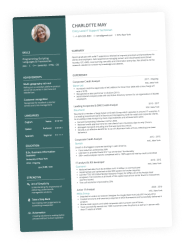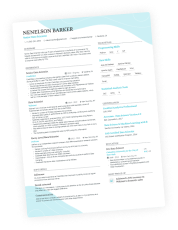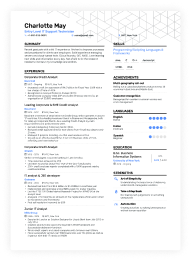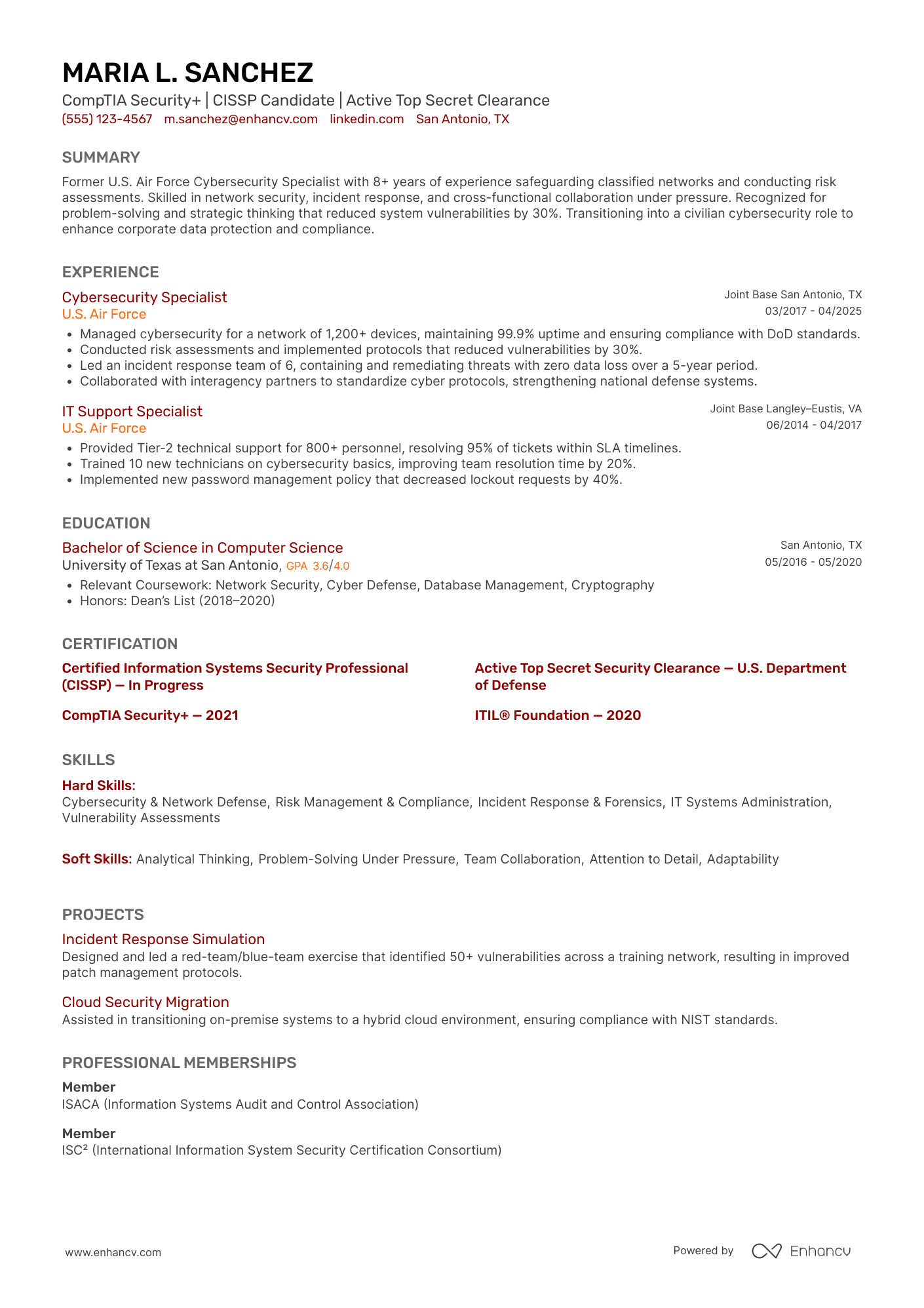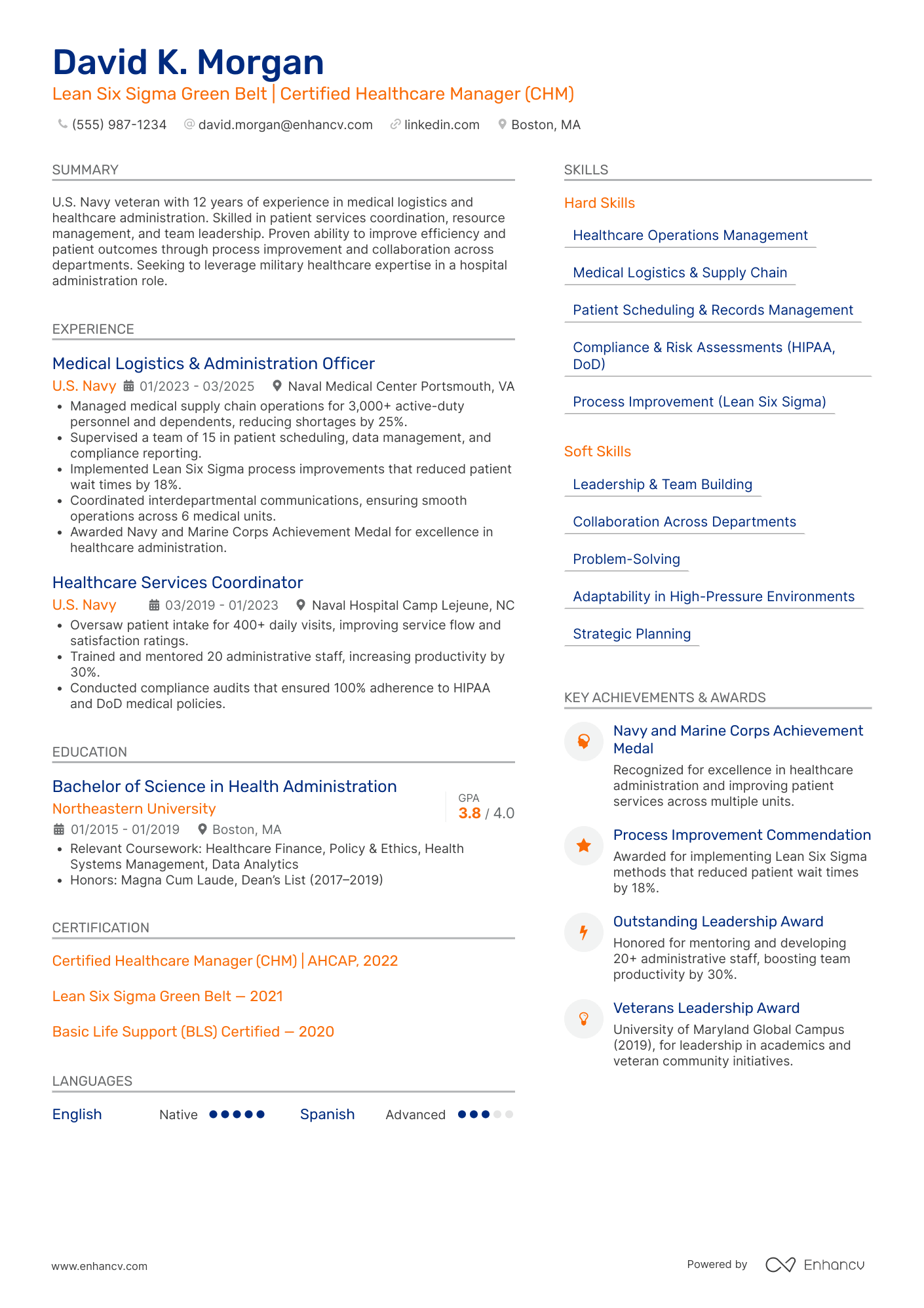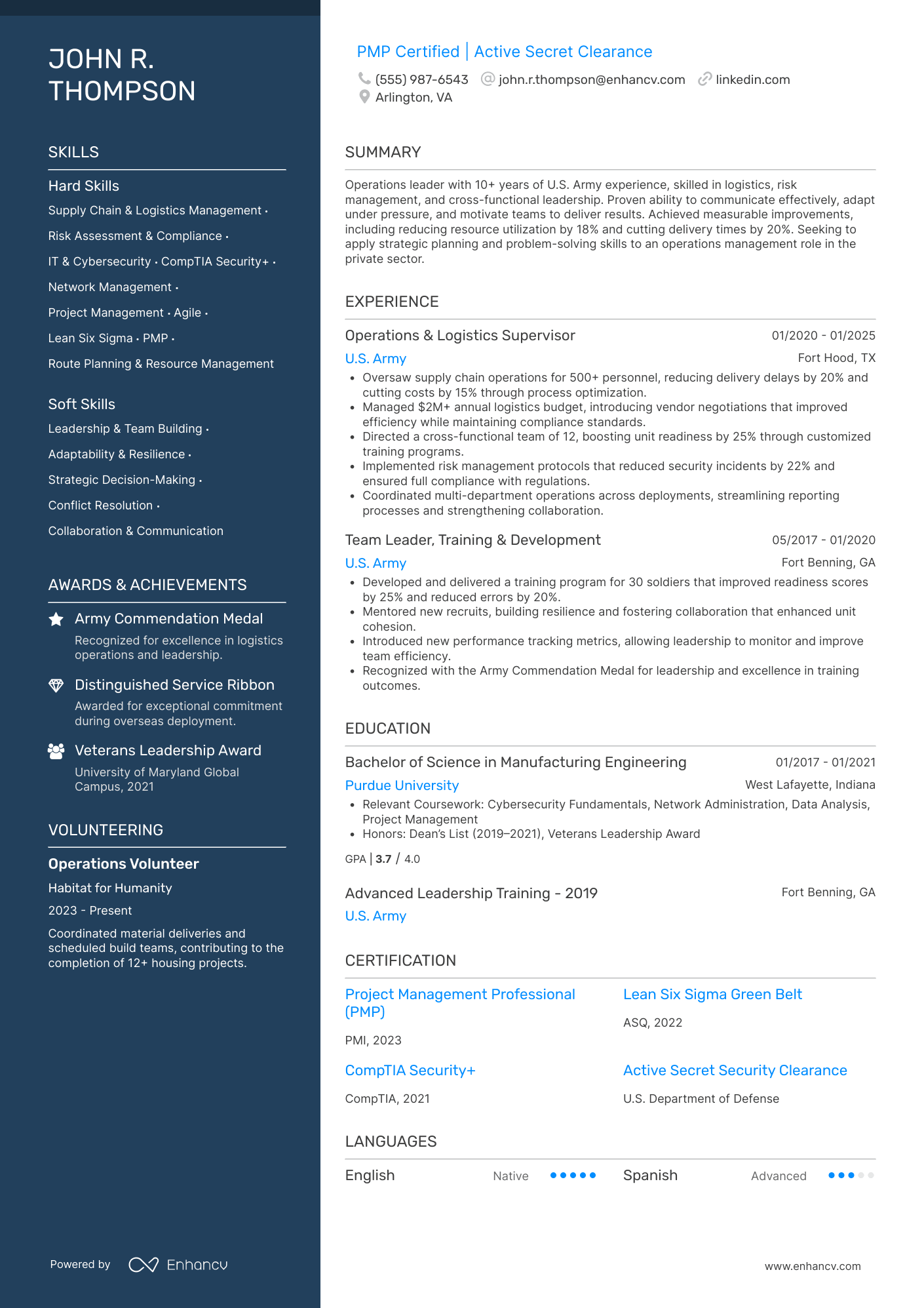Transitioning from military service to civilian life can feel like a daunting challenge. While your career has been defined by leadership, adaptability, and technical expertise, employers outside the military may not immediately see how those skills translate.
A strong military-to-civilian resume bridges this gap. It converts your unique background into civilian-friendly language, highlights measurable achievements, and showcases the transferable skills that make you an invaluable candidate.
In this guide, we’ll walk you through the key resume sections and strategies to create a resume that resonates with hiring managers.
Key takeaways
- Translate military jargon into civilian-friendly terms.
- Tailor your resume profile (summary or objective) for civilian roles.
- Emphasize leadership, teamwork, adaptability, and certifications.
- Quantify accomplishments with data and percentages.
- Use templates, examples, and AI resume builders for polish.
- Leverage job search resources and civilian reviewers for support.
Now that you know the key takeaways, let’s look at resume examples that put these strategies into practice.
How to choose the best resume format for a military-to-civilian resume
Choosing the right resume format is one of the first—and most important—steps in your transition. A clear, structured layout makes it easier for civilian hiring managers to recognize your skills and career progression, while also ensuring your achievements don’t get lost in translation.
The right format highlights your strengths, whether that’s leadership experience, technical training, or adaptability in new environments.
Which resume format should a veteran use?
Most veterans benefit from a reverse chronological format, which shows career progression and highlights increasing responsibility over time. This makes promotions, leadership growth, and achievements easy to scan.
Exception:
If you’re changing careers entirely or have highly transferable skills but less direct civilian experience, a hybrid (combination) format works better. It lets you front-load skills and certifications before detailing your work history.
What sections should go on a military-to-civilian resume?
Civilian hiring managers expect a clear structure that emphasizes relevant skills and results.
Most resumes should follow this order:
- Header (contact info, certifications, clearances)
- Resume profile (summary or objective tailored to your career goals)
- Work experience (translated into civilian terms, quantified results)
- Education (degrees and relevant military-to-civilian training)
- Certifications (industry-specific or military-translated credentials)
- Skills (both hard and soft skills, separated clearly)
Optional sections like awards, projects, or volunteer work can add weight to your application.
How to write your military-to-civilian resume work experience
Your work experience is proof that your military background translates into real-world value for civilian employers. Recruiters don’t just want to know the duties you performed—they want to see the scale of your responsibilities, the measurable results you achieved, and how you led people through complex situations.
Every military-to-civilian resume experience section should show:
Job title and branch/role: Translate military titles into civilian-friendly equivalents (e.g., Platoon Leader → Team Leader; Logistics Officer → Supply Chain Manager).
Dates of service: Use consistent formatting so your career timeline is clear.
Location: City and state/country of deployment or base.
Three to five bullet points that highlight:
- Scope: Team size, budget responsibility, or mission complexity.
- Tools and processes: Translate military systems into civilian terms (e.g., “operations orders” → “strategic planning”).
- Leadership: Managing teams, mentoring, or coordinating cross-functional groups.
- Results: Cost savings, efficiency gains, risk reduction, or successful completion rates.
By structuring your experience this way, you show civilian hiring managers that your military service wasn’t just about responsibilities—it was about delivering results, leading people, and solving problems under pressure.
Let’s quickly have a look at a well-written example:
Good example of a military-to-civilian resume experience section
Operations & Logistics Supervisor
U.S. Army | Fort Hood, TX
Jan 2016 – Dec 2022
- Directed supply chain operations for a battalion of 500+ personnel, reducing delivery delays by 20% and cutting costs by 15%.
- Managed $2M+ annual logistics budget, ensuring compliance with strict risk management protocols and efficient resource utilization.
- Led and trained a 12-member cross-functional team, achieving 100% mission readiness and improving performance metrics by 25%.
- Implemented new route planning strategies that improved transportation efficiency and reduced fuel usage by 10%.
- Coordinated operations across multiple departments, strengthening collaboration and streamlining reporting processes.
How to tailor your military-to-civilian resume experience
Tailor your bullets to each job description by:
- Replacing acronyms with civilian terms (e.g., “NCOIC” → “Team Leader”).
- Highlighting directly transferable skills (e.g., logistics → supply chain management).
- Mirroring employer keywords (e.g., “risk management,” “operations coordination”).
- Connecting achievements to business outcomes, not just mission success.
Resume tailoring examples for veterans
| Job description excerpt | Untailored bullet | Tailored bullet |
|---|---|---|
| Experience in supply chain management, inventory control, and cost reduction. | Responsible for supply distribution for unit. | Oversaw supply chain operations for 500 personnel, cutting delays by 20% and reducing costs by 15%. |
| Strong leadership skills with the ability to motivate and manage diverse teams. | Led a squad during missions. | Directed and motivated a 12-member team, achieving 100% mission readiness and improving performance by 25%. |
| Risk management and compliance expertise required for operations roles. | Conducted OPSEC for unit activities. | Implemented risk management protocols that reduced security incidents by 22% while ensuring compliance standards. |
How to quantify your experience on a military-to-civilian resume
Numbers make your impact clear. For veterans, quantifying achievements is especially important because it translates military responsibilities into results that civilian employers can immediately understand.
Instead of listing duties, use data, percentages, and figures to show the scale of your work, how you managed resources, and the outcomes you delivered.
Use the STAR Method
The STAR method (Situation, Task, Action, Result) helps translate your military duties into powerful, civilian-friendly achievements. Instead of just listing responsibilities, frame each bullet to show the context, what you were tasked with, the actions you took, and the results you delivered.
Check out the example below:
Before:
- Responsible for leading training exercises.
After (STAR):
- Led (Action) a 30-person training program (Task) after identifying readiness gaps (Situation), increasing proficiency scores by 25% (Result).
Let’s continue with some more illustrations of how to formulate effective bullets.
Examples of how to quantify military achievements on your resume
| How to quantify | Example bullet point |
|---|---|
| Show budget responsibility | “Managed $2M+ logistics budget, reducing costs by 15% through vendor negotiations.” |
| Highlight mission success rates | “Led 30-member unit to achieve 100% mission readiness and 95% on-time completion rates.” |
| Demonstrate efficiency gains | “Implemented new supply chain process that cut delivery delays by 20%.” |
| Emphasize risk reduction | “Introduced risk management protocols that reduced safety incidents by 22%.” |
| Measure training or performance improvements | “Developed a training program that boosted team proficiency by 30% and reduced errors by 25%.” |
Quantifiable results turn your service record into a business case for hiring you—proving you can deliver measurable value in civilian roles.
How to list your hard and soft skills on your military-to-civilian resume
Skills are a critical part of your military-to-civilian resume because they show employers both the technical expertise you bring and the personal qualities that make you effective in a team.
Civilian hiring managers want to know you can handle the technical requirements of the role while also leading, adapting, and collaborating. Separating your hard and soft skills—and presenting them with examples—ensures recruiters see the full range of what you offer.
Best hard skills for your military-to-civilian resume
Hard skills are technical and role-specific abilities.
Examples include:
- Logistics and supply chain management
- Project management methodologies (Agile, Lean Six Sigma)
- IT and cybersecurity certifications (CompTIA Security+, CISSP)
- Risk assessment and risk management protocols
- Route planning and resource management processes
Best soft skills for your military-to-civilian resume
Soft skills highlight interpersonal strengths valued in civilian workplaces:
- Team leadership and collaboration
- Adaptability and resilience
- Strategic decision-making
- Conflict resolution
- Time prioritization
- Cross-functional communication
PRO TIP
List hard skills in the dedicated “Skills” section but show soft skills through your bullet points and resume profile.
Here’s an example of how you might present your soft skills in a way that resonates with civilian hiring managers:
How to list your certifications and education on your military-to-civilian resume
For veterans, the education and certifications section is a powerful way to show employers that your skills are both transferable and up to industry standards. Civilian hiring managers often use this section to filter candidates who meet minimum qualifications— especially in technical, security, or operations roles.
What to include in an education entry:
- Degree and major
- University or institution name
- GPA (if 3.5 or higher)
- Location
- Graduation year (skip the month)
- Relevant coursework, military-to-civilian education, or honors (only if you’re early in your career or changing industries)
What to include in a certification entry:
- Certification title (e.g., PMP, Lean Six Sigma Green Belt, CompTIA Security+)
- Issuing organization (PMI, CompTIA, etc.)
- Year awarded (and expiry year if applicable)
- Security clearances (e.g., Secret, Top Secret) listed separately, with “Active” status if still valid
Example (for a job requiring Agile and formal training):
Education
Bachelor of Science in Information Technology
University of Maryland Global Campus | Adelphi, MD
Graduated: 2021 | GPA: 3.7
- Relevant Coursework: Cybersecurity Fundamentals, Network Administration, Data Analysis, Project Management
- Honors: Dean’s List (2019 – 2021), Veterans Leadership Award
Advanced Leadership Training
U.S. Army | Fort Benning, GA
Completed: 2019
Certifications
- Project Management Professional (PMP) | PMI, 2023
- Lean Six Sigma Green Belt | ASQ, 2022
- CompTIA Security+ | CompTIA, 2021
- Active Secret Security Clearance | U.S. Department of Defense
PRO TIP
Translate military training programs into civilian-friendly terms.
Instead of listing: “Advanced NCO Academy,” say “Advanced Leadership Training, U.S. Army.”
This makes your qualifications immediately clear to employers unfamiliar with military structures.
Once your education and certifications are clear, the next step is crafting a strong profile that introduces your skills and value right away.
How to write your military-to-civilian resume profile
Your resume profile—either a summary or objective—sets the tone for the application.
Resume summaries: Best for veterans with years of experience. They provide a snapshot of leadership, achievements, and technical skills.
Example:
“Operations leader with 10 years of military experience, skilled in logistics, risk management, and cross-functional leadership. Proven record of reducing resource utilization by 18% while leading teams of 20+.”
This resume summary is strong because it highlights transferable skills (logistics, risk management, leadership), uses a quantifiable achievement (18% resource reduction), and shows the scope of responsibility (teams of 20+). Together, these elements quickly prove value to civilian employers.
Tips for writing a strong profile
- Tailor it to the role.
- Focus on measurable results.
- Avoid military jargon.
- Highlight transferable skills and enthusiasm for the job.
Get a resume summary that proves your leadership and impact.
Drop your resume here or choose a file.
PDF & DOCX only. Max 2MB file size.
If you’re just starting out or don’t have direct civilian experience, your resume can still stand out by focusing on transferable skills and training.
How do I write a military-to-civilian resume with no experience?
If you lack direct civilian experience, emphasize transferable skills, training, and education.
What to include:
- Relevant coursework and certifications (e.g., IT, logistics, healthcare).
- Volunteer work, internships, or academic projects.
- Leadership roles within service (e.g., training, mentoring, organizing events).
- Functional or hybrid formats to emphasize skills over job titles.
Changing careers
Resume summaries are especially useful for those changing careers, as they highlight transferable skills and show employers how military experience applies directly to civilian roles.
Example:
“Former U.S. Army logistics officer transitioning into civilian supply chain management. Skilled in team leadership, strategic planning, and resource management, with a proven record of cutting delivery times by 20% and improving efficiency under high-pressure conditions. Adaptable and eager to apply problem-solving and collaboration skills to streamline operations in the private sector.”
Not sure if your military experience translates well? Run your resume through Enhancv’s Resume Checker—it scans for formatting, keywords, and clarity, then shows you how to better present your service for civilian employers.
Is your resume good enough?
Drop your resume here or choose a file. PDF & DOCX only. Max 2MB file size.
Additional resources for veterans
These sections add value outside the resume itself.
Accessing additional job search resources
Leverage resources like:
- Veterans centers and career services (career counseling, resume reviews).
- Indeed for Military and other veteran-specific job platforms.
- Academic advisors or admissions counselors for education alignment.
- Organizations supporting prior service members with networking and online courses.
Seeking feedback and civilian review
Getting outside feedback is one of the fastest ways to improve your military-to-civilian resume. A civilian professional—whether a career counselor, recruiter, or colleague—can flag jargon, unclear phrasing, or gaps you might miss and help align your document with employer expectations.
Before sharing it, run your draft through Enhancv’s free Resume Grammar Checker. It quickly spots grammar, spelling, and formatting issues, so your resume is refined and professional when you ask for feedback.
Utilizing resume templates and examples
Start with a military-to-civilian resume template for structure.
Ensure:
- ATS-friendly fonts (Arial, Calibri, Lato).
- Accomplishment-driven bullet points.
- Clear format (chronological or hybrid, depending on your path).
Enhancv’s free AI Resume Builder simplifies the process by converting your military background into a polished, professional civilian resume. With intuitive design, ATS-friendly templates, and tailored suggestions, it helps you confidently step into the civilian workforce.
With these resources in hand, you may still have questions about building your military-to-civilian resume—let’s address the most common ones.
Frequently asked questions about military-to-civilian resumes
Transitioning from the military to the civilian workforce often raises practical questions about resumes. These FAQs cover the concerns veterans most often have when preparing their applications.
What should your military-to-civilian resume header include?
Your header should make it easy for recruiters to contact you while also signaling credibility through relevant certifications or clearances.
Every military-to-civilian resume header should show these essentials:
- Full name
- Phone number
- Professional email address (firstname.lastname@email.com works best)
- City & state (no full address needed)
- LinkedIn or portfolio link
- A headline with certifications or clearances (e.g., “PMP Certified | Secret Clearance”)
PRO TIP
Avoid adding a photo unless it’s specifically required in your country. In the U.S., U.K., and Canada, including one can create bias concerns and is usually discouraged.
What design rules should you follow?
Your resume design should help both applicant tracking systems (ATS) and civilian hiring managers scan your experience quickly.
Follow these design rules for a military-to-civilian resume:
- Margins: 0.5–1 inch on all sides
- Fonts: Use ATS-friendly fonts like Arial, Calibri, or Lato
- Colors: Keep it clean with subtle accents for section headers
- Columns: One or two, as long as the structure is easy to follow
- Length: One page if under 10 years of service, two pages if your experience includes multiple deployments and leadership roles
ATS reality check
Formatting details like fonts, colors, or columns won’t block ATS parsing. What matters is consistent date formatting, simple bullet symbols, and including relevant keywords from job postings. Clarity always beats keyword stuffing.
Make sure your military-to-civilian resume passes the first test.
Run it through Enhancv’s free ATS-optimized Resume Scanner to check formatting, keywords, and structure—so your service translates clearly and gets past applicant tracking systems.
How should you save and name your military-to-civilian resume?
The way you save and name your resume affects how easily recruiters can open and track your file.
Keep in mind:
- Save as PDF unless otherwise requested—this preserves formatting.
- Use a clear file name: Firstname-Lastname-Position-Resume.pdf.
How to show career progression on a military-to-civilian resume
Employers want to see how you’ve grown in responsibility during your service. Highlighting progression shows readiness for civilian leadership roles.
Tips to highlight career progression:
- Show increasing responsibility (larger teams, broader missions, bigger budgets).
- Highlight promotions and title changes (e.g., Sergeant → Staff Sergeant → Platoon Leader).
- Demonstrate leadership growth by quantifying team sizes or operational impact.
- Include strategic contributions (risk assessments, training programs, process improvements) beyond day-to-day duties.
- Mention certifications that reinforce advanced skills (Lean Six Sigma, PMP, cybersecurity).
What are good additional sections for a military-to-civilian resume?
Optional sections can help you stand out and show depth beyond your main roles.
Useful additional sections include:
- Awards and decorations: Highlight leadership, excellence, or technical expertise.
- Projects: Showcase mission-critical or high-impact initiatives.
- Languages: Valuable for international roles or companies with global operations.
- Volunteer work: Reflects community involvement and team leadership outside of service.
- Professional memberships: Connects you with industry groups or veteran organizations.
Do I need industry-specific experience to get a civilian job?
Not always. Many military skills are highly transferable—such as logistics, risk management, team leadership, and technical expertise. What matters is translation.
If you’re shifting industries, tailor your resume by:
- Using terminology familiar to the target field.
- Highlighting outcomes that match the role (e.g., resource management for supply chain, cybersecurity for IT).
- Demonstrating adaptability in diverse environments.
What should I include in a cover letter for a civilian role?
Your cover letter should connect your military background to the civilian job, not repeat your resume.
Focus on:
- How your leadership and adaptability match the company’s goals.
- One example of a complex problem you solved under pressure.
- A closing statement about how you can contribute to their mission.
Even one short, tailored paragraph is better than a generic template.
Use Enhancv’s Cover Letter Generator to highlight your transferable skills, explain your career transition, and show employers why you’re the right fit.
Drop your resume here or choose a file.
PDF & DOCX only. Max 2MB file size.
How technical should a military-to-civilian resume be?
It depends on the role. Civilian employers need to see both technical fluency and strategic thinking.
- If applying for IT roles: highlight cybersecurity certifications, systems managed, and risk management protocols.
- If applying for logistics roles: emphasize supply chain management certifications and quantifiable efficiency gains.
Balance technical detail with measurable business outcomes—employers want to see the impact, not just the process.
How much do veterans earn after transitioning to civilian careers?
According to the U.S. Bureau of Labor Statistics and veteran employment reports, salaries vary widely depending on the industry and role. On average, veterans in civilian jobs earn about 10–15% more than non-veterans in similar positions, thanks to leadership skills, certifications, and security clearances.
Median annual salary for veterans by industry (approximate ranges)
| Industry | Median annual salary |
|---|---|
| Cybersecurity & IT | $95,000–$120,000 |
| Logistics & supply chain | $70,000–$95,000 |
| Aerospace & defense contracting | $100,000–$135,000 |
| Government & public administration | $65,000–$85,000 |
| Healthcare & medical administration | $75,000–$105,000 |
PRO TIP
Veterans with technical certifications (cybersecurity, IT support, Lean Six Sigma) or active clearances often qualify for higher-paying roles in federal contracting, defense, and tech.
Which industries hire veterans the most?
Veterans often thrive in industries that value discipline, technical skill, and leadership.
According to veteran employment data, the top industries for military-to-civilian hires are:
- Government and defense contracting
- Cybersecurity and IT services
- Transportation and logistics
- Healthcare administration
- Manufacturing and operations management
These sectors not only hire veterans at high rates but also offer strong career progression opportunities.
Conclusion
Transitioning from military to civilian life requires more than updating a document—it’s a process of translation, reframing, and showcasing your worth in new terms. By quantifying your achievements, highlighting certifications, tailoring objectives, and seeking civilian feedback, you’ll craft a resume that resonates with hiring managers.
Make one that's truly you.

